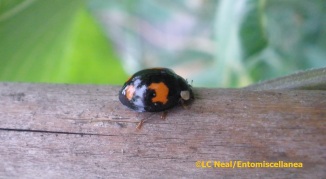Ladybirds are known as ‘helpful insects’, eating aphids before they can eat our flowers. But then there’s the issue of certain varieties (namely those of the species harmonia axyridis, or Harlequin ladybirds), which are considered, in the UK, to be a threat to native species. This is because the rapid spread of this foreign ladybird has seen a decline in other, native types, especially the two-spot. It competes for prey and habitat, and has also been known to eat native ladybirds apparently! Its spread certainly has been rapid, as this image shows: http://www.ladybird-survey.org/harlequin_spread_UK.aspx. The danger is that if the other varieties die out, we will rely on only the Harlequin for aphid control.
Last year I spotted two types of Harlequin ladybird in the garden:
This year I was thrilled to see that we had many of the native, and once most common, seven-spot ladybirds (coccinella septempunctata). Two days ago I even found a 14-spot ladybird (propylea quatuordecimpunctata), which was still around today.
However, there is a cuckoo in the nest, as I’ve identified larvae I saw last month as being of the Harlequin. They will be turning into adult ladybirds soon, if not already. If this photo’s anything to go by, they’re certainly helping the aphid control:
Who knows what else is going on in that picture, with the ant and some other creature? I wish my macro lens was better.
As a side note, I don’t advocate killing Harlequin ladybirds or their larvae. There is a chance of misidentification, for one thing, as they are similar to native species, and I would feel uncomfortable with the idea anyway.
I’m fairly sure the larva pictured is of a Harlequin thanks to this useful guide: http://www.ladybird-survey.org/downloads/Ladybird%20larvae_v.1.4.pdf
EDIT: This is a very helpful guide to the native and non-native UK species of ladybird: http://www.bbc.co.uk/news/magazine-14043356. Some fascinating types here. It may also explain the ant in the picture: it could be defending the aphids against the ladybird nymphs, as it likes the sugary liquid that aphids produce.




